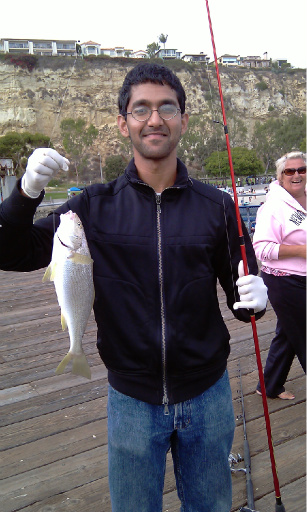 Yellowfin croaker, Crystal Pier in San Diego
Yellowfin croaker, Crystal Pier in San Diego
Species: Umbrina roncador (Jordan & Gilbert, 1882); from the Greek word umbra (shade, referring to its darkened, shady sides) and the Spanish word roncador (a snorer, or to snore). It is, afterall, a croaker.
Alternate Names: Surf fish, golden croaker, Catalina croaker, yellowtailed croaker and yellowfinned roncador. In Mexico they’re called berrugata aleta amarilla or verrugato de aleta amarilla.
 Yellowfin croaker, San Clemente Pier
Yellowfin croaker, San Clemente Pier
Identification: Elongated, croaker-like body with a blunt, rounded snout and small subterminal mouth. Yellowfins have a large, fleshy barbel at the tip of the lower jaw that separates it from other croakers with the exception of corbina. Their coloring is a blue to grayish-tan on the back with brassy and golden reflections; silver overlaid with dark yellow-brown wavy lines on the sides and bright yellow or golden fins. The coloring blends in and renders them almost invisible against a sandy background.
Size: Up to 18 inches and nearly 4 pounds, although most caught off piers are less than 14 inches. The California record fish weighed 3 lb 14 oz and was taken from Santa Monica Beach in 2000.
 Yellowfin croaker, Malibu Pier
Yellowfin croaker, Malibu Pier
Range: Bahia Magdalena, southern Baja California and Gulf of California to Point Conception (although reported from San Francisco in the 1800s).
Habitat: Common in shallow-water sandy areas, both oceanfront and in bays.
 Yellowfin croaker, Oceanside Pier
Yellowfin croaker, Oceanside Pier
Piers: Caught year round although the summer months, especially July and August, are considered the best months. Best bets: Crystal Pier, Oceanside Pier, San Clemente Pier, Huntington Beach Pier, Seal Beach Pier, Belmont Veterans Memorial Pier, Manhattan Beach Pier and Malibu Pier.
 Yellowfin croaker (top), Spotfin croaker (bottom), San Clemente Pier
Yellowfin croaker (top), Spotfin croaker (bottom), San Clemente Pier
Shoreline: One of the main catches by sandy shore anglers in southern California.
Boats: A mainly inshore species although a few are taken by boaters fishing SoCal bays.
Bait and Tackle: Use light to medium tackle; high/low surf leaders with number 6 or 4 hooks. Fish with fresh mussels or ghost shrimp. Other good baits are clams, sand crabs, bloodworms, lug worms and innkeeper worms. Fish from the surf area to midway out on the pier.
Food Value: In the past this was considered a very good, mild-flavored fish. Today there are warnings in many areas against eating croakers. They are a bottom feeder and in polluted areas tend to accumulate toxins in their body (because of the food they eat). If you do eat them, it is best to bake or broil them in such a manner that the fats in the flesh will drop away from the meat. (I must admit it is hard to write this since pan-fried croaker was a delicacy most of my life, but be warned).
 Yellowfin croakers (left), spotfin croaker (right), San Clemente Pier
Yellowfin croakers (left), spotfin croaker (right), San Clemente Pier
Comments: Yellowfin croaker are attractive fish that reach a decent size and put up a scrappy battle. By far, the best time to catch yellowfin croaker is around sundown and the early hours of the night. Illegal to take in California with nets since 1909, or to buy or sell since 1915. Of note is a study conducted on surf species by the Fish and Game Department between 2007-2009 in the Bolsa Chica to Hermosa Beach area. The study showed an increase in the number of yellowfin croaker from the 1990s and stated the yellowfin croaker were “much more abundant in the current study than in the 1950s.”
















I’ve caught these fish numerous times while throwing lures for halibut from the beach. I finally took one home last year and fried it up pollution and all. It was damn good.
When I was a kid, back in the 50′s, my father and I would catch Spot Fin and Chinese Croakers in Mission Bay. But that ended when they dredged the bay. Sure miss those days. Now lucky to get a rock bass.
Yellowfin, Spotfin & Black Croakers of good size can still be taken in Mission & San Diego Bays. For Spotfins in our bays, it helps to find the clam beds and fish right on top of them on a falling high tide to low tide. Ghost shrimp, Razor & Pismo clams are my go to baits but, I’ve also brought them home for dinner by using raw market shrimp & long thin strips of squid & on a 1/2oz Krocodile. Mojarra Frita is by far my favorite way to eat this fish, the skin tastes so good. I’ve even eaten yellowfin croaker as sashimi. I believe that most of the people that are telling “fish stories” about the pollution in our bays, are good story tellers but, lack actual fact based, peer reviewed scientific reports to back up their claims.
Mission Bay is where I first fished for big spotfin croaker. Later my dad would daily go down and dig up some ghost shrimp and use them to pursue the fish.